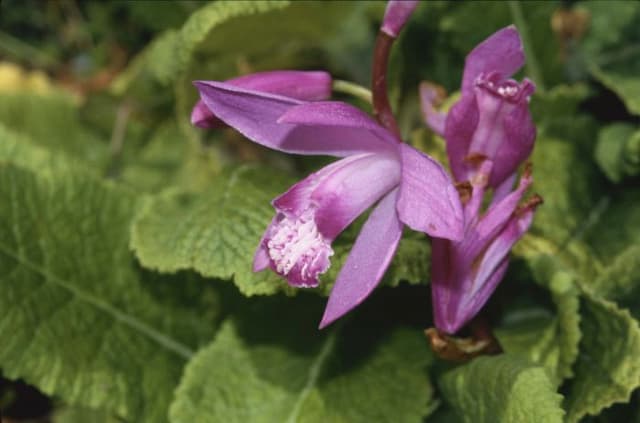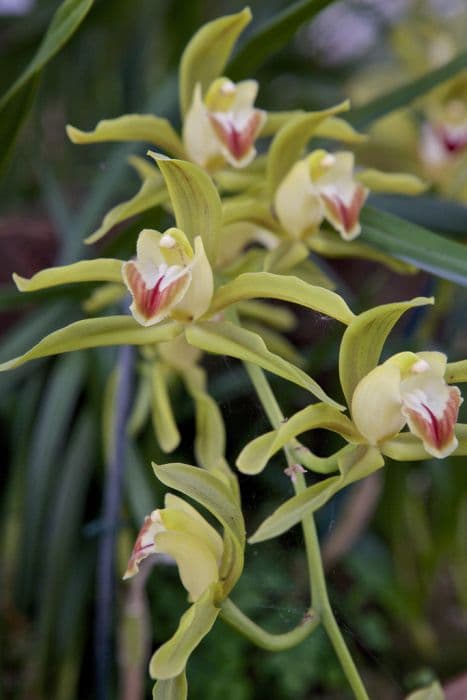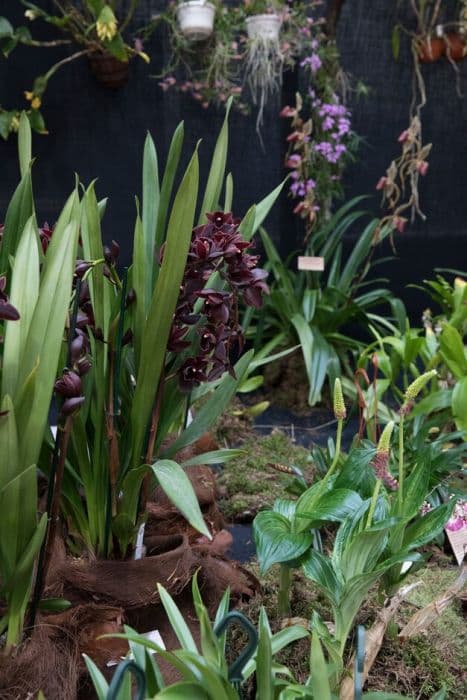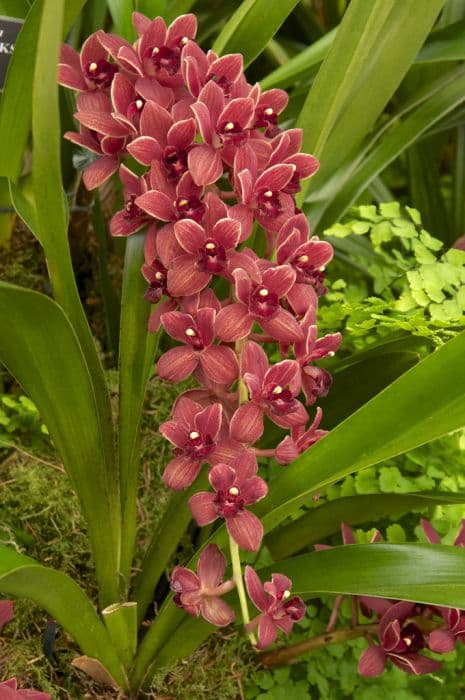Pink Rock Orchid Dendrobium kingianum
ABOUT
The Pink Rock Orchid, known for its beauty and resilience, is an intriguing plant with a unique and attractive appearance. It typically exhibits a cluster of cane-like stems, which are slender and often appear as if they are creeping or trailing. These stems carry the plant's foliage, which consists of elongated, leathery leaves that can vary in shades, displaying hues of green that can sometimes have a purplish tinge, particularly when exposed to ample sunlight or lower temperatures. The plant captivates onlookers when in bloom, presenting clusters of fragrant flowers that emerge from the tops of the canes. These blossoms can range from pink to purple and sometimes may appear almost white, providing a delightful contrast against the foliage. The flowers are relatively small yet numerous, with each one composed of a whorl of petal-like structures surrounding a central, often contrasting lip that beckons pollinators. The blooms are known not just for their visual appeal but also for their delightful fragrance, which can vary in intensity and is most noticeable during the morning hours. The Pink Rock Orchid's overall appearance is a showcase of robustness and ornamental charm, making it a prized species among orchid enthusiasts and a fascinating subject for anyone interested in the captivating diversity of flowering plants.
About this plant
 Names
NamesFamily
Orchidaceae
Synonyms
Pink Rock Orchid, Captain King's Dendrobium, The Sydney Rock Orchid
Common names
Dendrobium kingianum, Dendrobium tarberi, Thelychiton kingianus, Dendrobium cunninghamii, Callista kingiana.
 Toxicity
ToxicityTo humans
The Pink Rock Orchid is considered non-toxic to humans. There are no well-documented adverse effects or symptoms related to the ingestion of this plant. Therefore, it poses minimal risk if accidentally ingested. However, it is generally advised to avoid eating ornamental plants as a precaution.
To pets
The Pink Rock Orchid is not known to be toxic to pets such as cats, dogs, and other domesticated animals. Ingestion of this orchid should not lead to symptoms of poisoning, making it relatively safe around household pets. Nonetheless, it's always best to prevent pets from chewing on plants to avoid any potential digestive upset or unforeseen allergic reactions.
 Characteristics
CharacteristicsLife cycle
Perennials
Foliage type
Evergreen
Color of leaves
Green
Flower color
Varies
Height
1-2 feet (30-60 cm)
Spread
1 foot (30 cm)
Plant type
Orchid
Hardiness zones
9
Native area
Australia
Benefits
 General Benefits
General Benefits- Ornamental Value: Pink Rock Orchid (Dendrobium kingianum) is prized for its attractive, showy flowers that add visual interest to indoor and outdoor settings.
- Low Maintenance: It is relatively easy to care for, requiring minimal attention to thrive, making it suitable for beginner gardeners.
- Drought Tolerance: As an epiphytic orchid, it can withstand periods of drought, a helpful trait for regions prone to water scarcity.
- Temperature Resilience: It can tolerate a wide range of temperatures, which is beneficial for growing in various climates.
- Cultural and Heritage Value: Pink Rock Orchid holds cultural significance in certain communities, often used in various local traditions and horticultural societies.
- Habitat for Wildlife: When planted outdoors, it can provide habitats and resources for beneficial insects and pollinators like bees and butterflies.
- Long Bloom Period: It has a longer-than-average flowering season compared to some other orchids, ensuring longer periods of visual enjoyment.
- Compact Size: Its relatively compact growth habit makes it suitable for smaller spaces, such as apartments and terrariums.
 Medical Properties
Medical Properties- Antioxidant activity: Some studies suggest that Dendrobium kingianum, also known as Pink Rock Orchid, may have compounds with antioxidant properties that could help in protecting cells from oxidative stress.
- Anti-inflammatory properties: Extracts from Pink Rock Orchid have been researched for potential anti-inflammatory effects, which could potentially be beneficial in reducing inflammation.
 Air-purifying Qualities
Air-purifying QualitiesThis plant is not specifically known for air purifying qualities.
 Other Uses
Other Uses- Perfumery: The flowers of the Dendrobium kingianum, widely known as the Pink Rock Orchid, emit a delightful fragrance that can be used in the creation of perfumes and scented oils.
- Ornamental Displays: Pink Rock Orchid is commonly used in corsages and ornamental displays due to its vibrant and long-lasting flowers.
- Photography: The striking blooms of Pink Rock Orchid make it a popular subject for botanical photographers and enthusiasts.
- Educational Model: This orchid is sometimes employed in educational settings to demonstrate epiphytic plant growth and orchid care to students and hobbyists.
- Cultural Symbolism: In certain cultures, owning or gifting a Pink Rock Orchid may symbolize wealth or beauty, and it is sometimes included in cultural ceremonies.
- Horticultural Hybridization: Pink Rock Orchid is often used as a parent in hybridization efforts to create new orchid varieties with desirable traits.
- Art Inspiration: Artists might use the Pink Rock Orchid as a subject for botanical illustrations, paintings, and other forms of art due to its stunning appearance.
- Feng Shui: Some practitioners of Feng Shui may use Pink Rock Orchids in their practice to enhance energy flow and create a harmonious environment.
- Wedding Decor: Given their aesthetic appeal, Pink Rock Orchids are sometimes integrated into wedding bouquets, centerpieces, and venue decorations.
- Collectors' Item: Pink Rock Orchid, with its various color forms and ease of cultivation, is a favorite among orchid collectors and enthusiasts.
Interesting Facts
 Feng Shui
Feng ShuiThe Pink Rock Orchid is not used in Feng Shui practice.
 Zodiac Sign Compitability
Zodiac Sign CompitabilityThe Pink Rock Orchid is not used in astrology practice.
 Plant Symbolism
Plant Symbolism- Resilience: The Pink Rock Orchid, as Dendrobium kingianum is commonly known, is highly adaptable and can tolerate a range of conditions, symbolizing resilience and the ability to endure challenges.
- Purity: Orchids, in general, are often associated with purity and the delicate, pristine blooms of the Pink Rock Orchid further emphasize this characteristic.
- Beauty: Renowned for their beautiful flowers, Pink Rock Orchids symbolize beauty and elegance.
- Rarity: The Pink Rock Orchid, like many orchids, is considered relatively rare and exotic, which can symbolize uniqueness or preciousness.
- Refinement: Orchids have a reputation for being sophisticated and refined, making it a suitable symbol for those qualities.
- Fertility: Orchids have often been seen as a symbol of fertility and abundance, possibly due to their many seedlings.
- Love: In many cultures, orchids represent love, affection, and a strong bond between individuals.
 Water
WaterThe Pink Rock Orchid should be watered thoroughly whenever the mix just starts to dry out, which is typically every 5 to 7 days during the active growing season. During the winter or the plant's dormant season, reduce watering to about once every two weeks, allowing the mix to dry out more thoroughly between waterings. When you water, ensure to use enough water to run through the potting medium—using roughly 8-16 ounces depending on the pot size—to ensure it is evenly moistened. Overwatering can lead to root issues, so it's important to avoid letting the plant sit in water. During hot, dry weather, you might need to water more frequently.
 Light
LightFor the Pink Rock Orchid, provide bright, indirect sunlight by placing it in an east or west-facing window where it can enjoy the morning or afternoon sun. Avoid direct midday sun, which can scorch the leaves. If growing outdoors, dappled light, such as under a tree canopy, is ideal. Adequate light is important for the health of the plant and for flower production.
 Temperature
TemperaturePink Rock Orchids prefer a temperature range between 50°F to 85°F. They can tolerate night temperatures down to about 40°F and daytime temperatures up to about 100°F if they're not too prolonged. The ideal temperature range to encourage flowering is between 55°F to 75°F. Offering the plant cooler temperatures at night, about a 10°F drop from daytime temperatures, can help in stimulating bloom production.
 Pruning
PruningPruning your Pink Rock Orchid is important to remove any dead or yellowing leaves and spent flower spikes, which can be done at any time of the year as needed. Pruning after flowering encourages the growth of new shoots from which future blooms will emerge. Generally, this plant doesn't require extensive pruning; simply clean up any unsightly or unhealthy parts of the plant.
 Cleaning
CleaningAs needed
 Soil
SoilThe best soil mix for Dendrobium kingianum, commonly known as Pink Rock Orchid, should be well-draining orchid potting mix comprising medium fir bark, coarse perlite, and small charcoal pieces. This orchid prefers slightly acidic soil with a pH ranging from 5.5 to 6.5.
 Repotting
RepottingPink Rock Orchid should be repotted every two to three years or when the potting medium starts to decompose. Repotting is best done in spring after the flowering period.
 Humidity & Misting
Humidity & MistingPink Rock Orchid thrives in moderate to high humidity levels, ideally between 50-70%. Consistent humidity is key to the plant's health but it should not be overly wet.
 Suitable locations
Suitable locationsIndoor
Place in bright indirect light with good airflow.
Outdoor
Part shade, sheltered from direct sun and frost.
Hardiness zone
9-11 USDA
 Life cycle
Life cycleThe life of Dendrobium kingianum, also known as the Pink Rock Orchid, begins with seed germination, which is symbiotic, relying on mycorrhizal fungi to assist with nutrient absorption during sprout development. Once germinated, the plant grows a pseudobulb, from which leaves emerge to carry out photosynthesis; this stage can last several years as the plant matures. The Pink Rock Orchid enters a blooming phase usually in late winter or spring, producing fragrant flowers that can range from pink to purple in color. After pollination, which is predominantly carried out by insects, the plant forms seed capsules filled with thousands of tiny seeds, which, when mature, are dispersed by wind. When these seeds land in a favorable environment and encounter the requisite fungi, a new generation begins, closing the life cycle. Throughout its lifetime, Dendrobium kingianum can produce multiple offshoots or keikis from the nodes along the pseudobulbs, which can be naturally propagated to form new plants.
 Propogation
PropogationPropogation time
Spring-Early Summer
Dendrobium kingianum, commonly known as Pink Rock Orchid, is most popularly propagated through division, a process best carried out in the spring after the plant has finished flowering. For this method, a mature Dendrobium kingianum is gently removed from its pot or growing medium. The grower should carefully separate the pseudobulbs, ensuring that each division has at least three healthy pseudobulbs. These divisions can then be potted into fresh orchid potting mix, making sure the oldest pseudobulb is at the edge of the pot to encourage new growth towards the center. After potting, water the divisions sparingly until new growth appears, indicating that the plant has established in its new pot.









